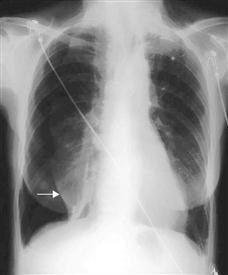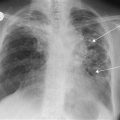Dyspnoea
Dyspnoea is the uncomfortable awareness of breathing.
History
Many cardiac or respiratory diseases of sufficient severity produce dyspnoea. When considering chronic respiratory causes, you may relate them anatomically to diseases of the pulmonary vasculature, airways, interstitium and chest wall. When approaching a patient with dyspnoea, it is important to ensure that the ABC are attended to before continuing with the diagnostic process.
Onset
The speed of onset is a useful indicator of the disease process. Classification by speed of onset narrows the differential diagnosis in urgent clinical situations.
Precipitating factors
An obvious precipitating factor may be present, such as trauma causing either fractured ribs or a pneumothorax. Aspiration of a foreign body may be determined from the history; however, aspiration of vomit is more difficult, as it usually occurs in patients with decreased consciousness levels or who have lost the gag reflex. Dyspnoea on recumbency is caused by cardiac failure; occasionally patients may complain of waking up at night gasping for breath when they slide down the pillows (paroxysmal nocturnal dyspnoea). Dyspnoea associated with asthma may be seasonal (grass pollen) or perennial (house-dust mite faecal proteins), depending on the precipitating allergen. A history of severe allergy should lead to the consideration of anaphylaxis. Stressful events can precipitate asthma attacks but may also cause anxious patients to hyperventilate.
Relieving factors
Dyspnoea resulting from cardiac failure may be relieved by sitting upright, and, when due to asthma, by beta agonists.
Associated factors
Cough productive of (green, yellow, rusty) sputum indicates the presence of a chest infection. This may be the primary cause or it may exacerbate dyspnoea in patients with an existing condition such as asthma, COPD or cardiac failure. Bloodstained sputum may result from a chest infection (especially TB), pulmonary embolism or a tumour. Wheezing may result from asthma or aspiration of a foreign body.
Examination
Inspection
Cyanosis, which is observed from the fingertips (peripheral) or in the mucous membranes (central), is an indicator of severe underlying disease. Decreased consciousness level may indicate a life-threatening situation. However, it may also be the presenting feature of patients with a metabolic acidosis (diabetic ketoacidosis). Kyphosis severe enough to cause dyspnoea should be evident on general inspection. Patients with COPD may appear barrel-chested and cyanosed or thin and tachypnoeic (with pursed-lip breathing) accompanied by the prominent use of the accessory musculature.
The respiratory rate per se may not be very specific but extremes may be indicators of severity of the underlying disease. The respiratory rate should be carefully counted and not just estimated.
The hands should be inspected for clubbing, as it is associated with bronchial carcinoma and idiopathic pulmonary fibrosis (p. 64).
Pulse
A change in rate or regularity of rhythm may indicate an arrhythmia as a precipitating factor (usually in pre-existing heart or lung disease). The rate itself is not, however, very specific to the underlying aetiology.
JVP
Acute elevation of the JVP suggests tension pneumothorax, pulmonary embolism, cardiac tamponade or tricuspid regurgitation (prominent v waves). Chronic elevation results from congestive heart failure or any chronic lung disease with right heart failure (cor pulmonale).
Trachea
The trachea deviates away from the side of a tension pneumothorax, pleural effusion and any large mass. It deviates to the side of a collapsed segment, which can result with obstruction of the bronchial lumen from tumour or foreign bodies.
Expansion
May be reduced on the side of an area of consolidation (infection), pneumothorax and effusion. It may be reduced bilaterally in patients with COPD.
Percussion
The area overlying consolidation, effusion or collapse is dull to percussion. Hyper-resonance is often described on the affected side of a pneumothorax; however, a ‘relative dullness’ of the unaffected side is the usual initial finding.
Auscultation of the precordium
Auscultation may reveal murmurs associated with valvular heart disease. The presence of a third heart sound is consistent with cardiac failure, and quiet heart sounds may be due to an overexpanded chest from COPD.
Breath sounds
Localised reduction in the intensity of breath sounds occurs over areas with consolidation or collapse of the lung; however, it may be reduced generally with asthma and COPD.
Added sounds
Wheezing may be appreciated in a localised area following intraluminal airway obstruction from an inhaled foreign body or tumour. Generalised wheezing usually occurs with asthma. When a history of pre-existing asthma is not evident, then consider anaphylaxis. Localised crepitations may be auscultated over areas of pulmonary consolidation. Extensive bilateral crepitations occur with idiopathic pulmonary fibrosis (fine inspiratory), pulmonary oedema and bronchopneumonia.
General Investigations
■ FBC
Hb ↓ points to anaemia as the primary cause or as an exacerbating factor of underlying disease. Hb ↑ (polycythaemia) may be seen in chronic lung disease. WCC ↑ usually indicates infection, but it can also occur with other conditions, such as pulmonary embolism.
■ Peak expiratory flow rate
This simple bedside test allows you to evaluate airflow limitation. A reduced flow rate may indicate asthma or chronic airflow limitation.
■ ECG
Arrhythmias are readily appreciated on the ECG; atrial fibrillation or supraventricular tachycardia may precipitate dyspnoea in patients with pre-existing heart or lung disease. However, an arrhythmia may be a manifestation of the underlying cause, such as myocardial infarction, pulmonary embolism and hypoxia. ST segment elevations occur with myocardial infarction and are also a non-specific finding in pulmonary embolism. Right bundle-branch block may occur in the presence of longstanding lung disease.
■ Pulse oximetry
Although low saturation per se is not very discriminatory, acute severe impairment of oxygen saturation is associated with pulmonary embolus and pneumothorax. Post-exercise desaturation is helpful if opportunistic pneumonia is suspected.
■ ABGs
Useful to quantify severity of the disease and subtype of respiratory failure. Normal levels of oxygenation, however, are not useful to exclude respiratory or cardiac disease. Low levels of bicarbonate indicate metabolic acidosis and should lead to the investigation of the underlying cause, such as diabetic ketoacidosis. An alkalosis (high pH) with low Pco2 and high Po2 points to hyperventilation. CO2 retention may result from chronic lung disease (type II respiratory failure) or may indicate the need for ventilation with co-existing hypoxia in asthmatics.
■ Serum cardiac markers
Cardiac troponin or CK-MB is elevated with myocardial infarction in the setting of acute left ventricular failure.
■ CXR
Hyperinflation of the lungs (if the hemidiaphragm is below the 7th rib anteriorly or the 12th rib posteriorly) is a feature of emphysema, and may also result from asthma. Areas of consolidation are seen on a plain film; however, radiographic changes of a chest infection may lag behind in time with the clinical findings. The presence of cardiac failure is appreciated by cardiomegaly, upper lobe diversion of the pulmonary veins, bilateral pleural effusions, Kerley B lines (1–2 cm horizontal lines in the periphery of the lung fields) and patchy pulmonary oedema. A pneumothorax may be diagnosed by identifying the line of the pleura and the absence of lung markings beyond it. Bronchial carcinoma may present as a hilar mass, peripheral opacity or collapse and consolidation of the lung due to airways obstruction.
Specific Investigations
■ Sputum and blood cultures
Should be taken if an infective aetiology (pneumonia, lung abscess) is suspected, preferably before antibiotics are administered.
■ Respiratory function tests
Apart from physiological measurements of the lung, spirometry allows classification of restrictive or obstructive lung defects. It can also provide information regarding severity of the disease and the response to inhaled bronchodilators. Flow volume loops can indicate fixed airways obstruction (plateau in the expiration phase), which can result from foreign body or intraluminal tumour. Restrictive pattern of ventilatory impairment is characterised by a normal FEV1 to FVC ratio and a reduced vital capacity. It is characteristic of pulmonary fibrosis, infiltrative lung disease and restriction of chest wall motion. Obstructive pattern of ventilatory impairment is characterised by a reduced FEV1 to FVC ratio and a normal vital capacity. It is characteristic of asthma, COPD, bronchiectasis and cystic fibrosis.
■ Bronchoscopy
Bronchoscopy should be performed if aspiration of a foreign body is suspected, the procedure can be both diagnostic and therapeutic. Intraluminal bronchial carcinomas may be visualised and biopsied. Bronchoscopy also allows collection of specimens for culture in the diagnosis of pneumonia.
■ CT thorax/pulmonary angiogram
The majority of pulmonary emboli may be diagnosed by CT pulmonary angiography. In addition, complete visualisation of the thorax by CT is useful to evaluate masses of unknown aetiology, and for staging of bronchial carcinoma. High-resolution CT is useful to screen for features of idiopathic pulmonary fibrosis.
■ Echocardiography
An echocardiogram is indicated if cardiac failure or valvular heart disease is suspected. A large pulmonary embolus can be diagnosed by a finding of right heart failure and elevated pulmonary artery pressures. Elevated pulmonary artery pressures can also be caused by pulmonary hypertension causing dyspnoea. Although a proportion are idiopathic, known causes are congenital heart disease, any severe lung disease and recurrent pulmonary emboli.





